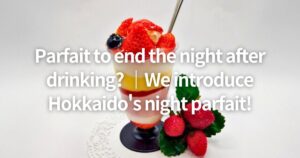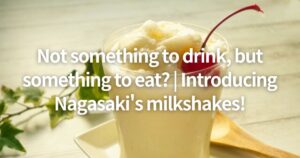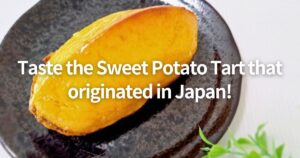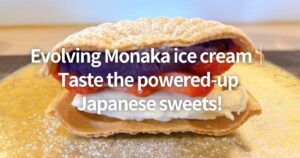In Japan, 3:00 p.m. is considered snack time, and when I was a child, I remember waiting anxiously for that time to arrive.
Among snacks, I loved Castella, and I remember going to my grandfather’s house or visiting friends and enjoying the delicious Castella served during snack time.
It is said that Castella was originally brought to Japan by the Portuguese during their trade in Nagasaki, but unlike the original Castella, it is said to have evolved in a way unique to Japan.
The moist egg dough is covered with a layer of coarse crumbles at the bottom, and the crunchy sensation is so addictive that even today, when I am tired, I still want to eat it.
In this article, I will explain the history of Castella, which has evolved uniquely in Japan, its appealing points, and recommended Castella stores, including my own experience.
I hope this will be a good opportunity for you to get to know Japanese Castella.
What is the history of Castella in Japan to begin with?
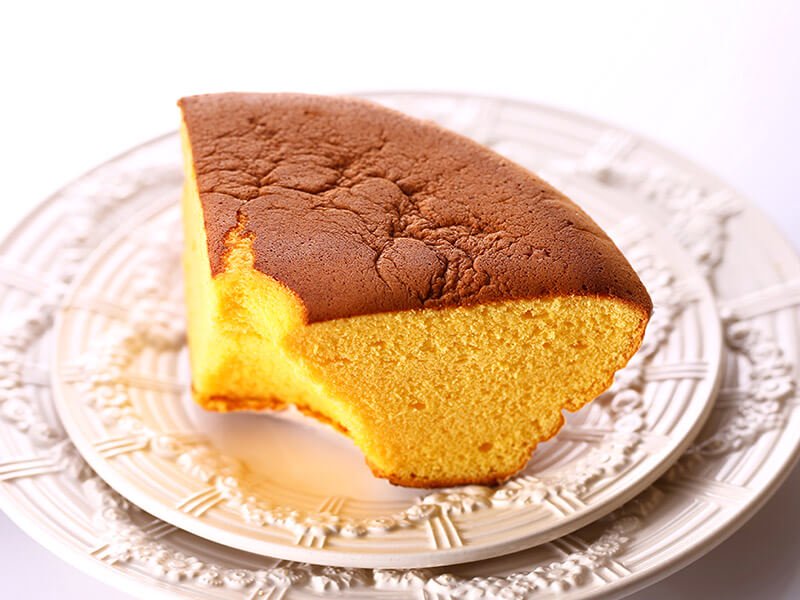

It is believed that Castella was introduced to Japan by the Portuguese in the 16th century through the Nanban trade.
In particular, Nagasaki was the first place where Castella was introduced to Japan as it was the hub of the Nanban trade, and it is still known as a Nagasaki specialty today.
Castella was first introduced to Nagasaki by the Portuguese during the Azuchi-Momoyama period of Nobunaga Oda and Hideyoshi Toyotomi in the late 16th century.
In the Edo period, there are records of Castella in Nagoya in 1644 and in Kyoto in 1681.
In the mid-Edo period, Castella was already being served at Edo Castle as a Japanese confectionery for the reception of imperial envoys.
How is it different from the original Portuguese Castella?
In Portugal, there is no confectionary named “Castella,” and the original confectionary is also different from Castella in appearance and production method.
The original type of Castella is considered to be the “Paondero,” which is simply made by whisking eggs and sugar together, adding flour, and baking in a kiln.
Like Castella, it does not contain any butter or other fats or oils.
Castella is a Nanban pastry that came from Portugal, but was adapted to Japanese tastes and production methods, resulting in the rectangular shape of today’s Castella.
The Japanese people added their own originality and ingenuity to the mixture and form to suit Japanese tastes, and through repeated technical improvements, the Castella of today has become more beautiful, softer, and more moist.
The use of syrup, a characteristic of Nagasaki Castella, is said to have started in western Japan during the Meiji period (1868-1912) and later, and it gave it its current moist texture.
Heh. The original Castella, “Paondero,” was simple and different from today’s Japanese Castella, wasn’t it?
Three Attractions of Castella in Japan
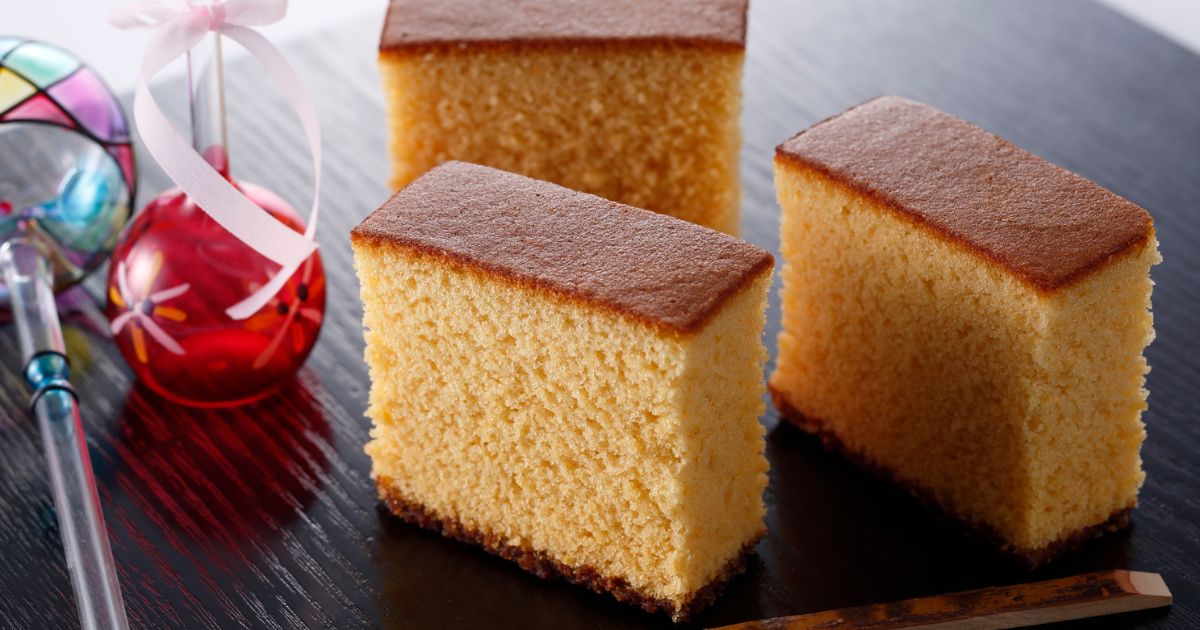

I have summarized some of the attractions of Castella that I find appealing.
Gentle flavor and elegant sweetness
Castella is a sweet made with plenty of eggs and sugar, and is popular among men and women of all ages.
Its sweet, fluffy, and gentle texture is popular among people of all ages, and its appeal is that it is not as sweet as cake and can be enjoyed without hesitation as a tea cakes.
Castella baked by skilled craftsmen are characterized by their glossy, bright baking color, moist and mild texture, and moderate sweetness.
The crunchy texture of the coarse sugar left on the bottom is also an attraction unique to the traditional Nagasaki Castella.
In particular, the high quality product called “Gosan Castella” has a 5:3 ratio of egg yolk to egg white, which gives it a richer egg flavor.
Wide Variety
In addition to the traditional plain type, you can also enjoy a variety of flavors.
For those who prefer Japanese flavors, we recommend matcha, anko (red bean paste), yuzu (yuzu citrus), and hojicha (roasted green tea), while for those who prefer Western flavors, we recommend chocolate, cheese, coffee, and other flavors.
The matcha Castella, in particular, is loved by people of all ages for its unique bitterness that accentuates the sweetness of the Castella, as well as its beautiful green color.
Castella made with wasanbon sugar is characterized by its elegant and mild sweetness, and honey castella made with honey is gaining popularity for its moist texture.
In recent years, unique products have been added to the lineup and continue to evolve, such as the “Castella Roll” made by wrapping Castella in dorayaki dough, or the luxurious taste of homemade jam sandwiched between two pieces of white chocolate.
Value as a souvenir or gift
Many Castella can be stored at room temperature, making them ideal as souvenirs or small gifts.
There are many famous stores throughout Japan, such as Fukusunaya and Shououken, famous for Nagasaki Castella, and Meibindo in Tokyo, and Castella from famous stores are valued as special souvenirs.
Many high-end Castella are individually wrapped, pre-cut into pieces, or gift items that are particular about their appearance and packaging, and are used as gifts for a wide range of occasions.
At long-established stores in Nagasaki, you can enjoy Castella made using traditional methods with a history of over 400 years, and some of them are so rare they are called “fantastic Castella” for which there is a six-month waiting list for reservations.
Castella from such historic and famous stores are popular among foreign tourists as a special experience to taste Japan’s traditional confectionery culture.
Indeed. In Japan, high-end Castella from famous stores are often brought as gifts to visitors rather than for personal use.
3 famous Castella stores I recommend
I will introduce 3 famous Castella stores that I recommend.
3 famous Castella stores I recommend
3 famous Castella stores I recommend
Fukusaya


✅ Recommended Points
- Founded in 1624 (early Edo period), Fukusunaya is one of the oldest and most established Castella stores, with a 400-year history and the registered trademark “Castella Honke”.
- The Castella are made using a process known as the “one-man consistency principle,” in which a single artisan handles the entire process from cracking the eggs by hand to baking the Castella.
- Fukusunaya’s Castella is made entirely by the skilled hands of artisans, without the use of a mixer, in keeping with the 400-year tradition of the traditional method.
- No honey or milk is used, and the eggs are exceptionally rich and thick.
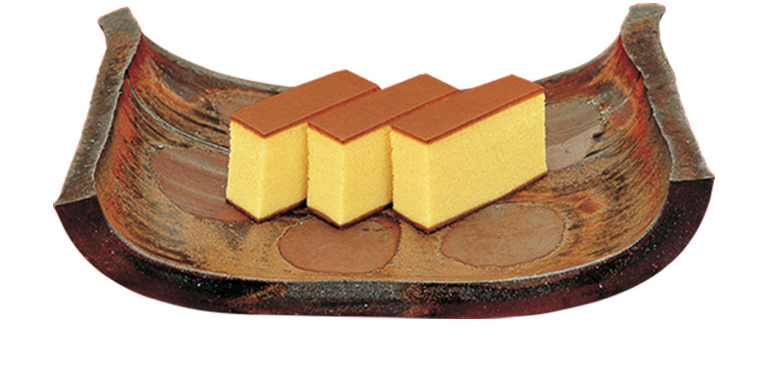

✅ Recommended products
- Special Gosan-yaki Castella
- “Gosan-yaki (Gosan-yaki) Castella” uses egg yolks more lavishly than regular Nagasaki Castella, resulting in a moist texture and rich, full dough.
- Recently, the company also began selling bite-sized Castella called “Castella Cubes” and uses different coloring and designs depending on the season, so you can take your favorite package as a souvenir.
Bunmeido Sohonten
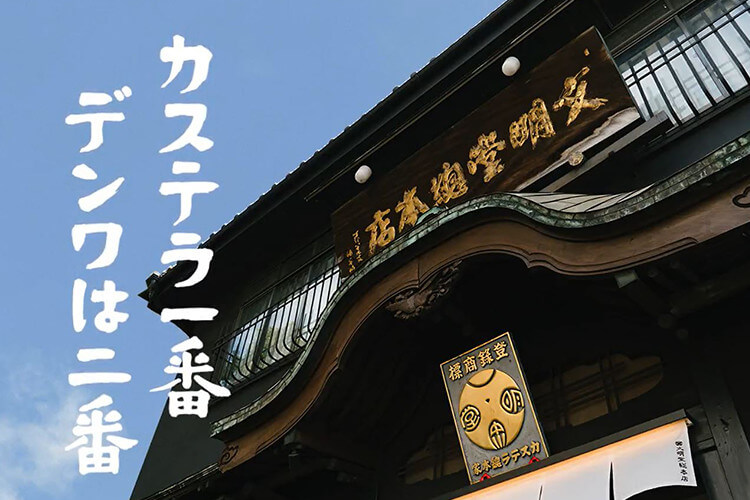

✅ Recommended Points
- “Bunmeido” has been spun off and expanded nationwide, and is highly recognized along with Fukusunaya.
- Although there are stores all over Japan, the origin and head family of the company is the FumiMyobindo Sohonten in Nagasaki.
- Known for its commercial song, “Castella first, phone second, three o’clock snack is Meibindo,” Meibindo is probably the most well-known of all.
- The Castella from Bunmeido Sohonten is made using a unique, well-researched process.
- From the stirring of the dough to the baking process, the Castella is carefully made using techniques passed down from craftsman to craftsman, and is characterized by its high-quality melt-in-your-mouth texture.


✅ Recommended products
- Castella Roll
- In addition to Castella, products include “Castella Roll” made by rolling Castella with Mikasa-yama (dorayaki) and “Special Castella” in a wooden box.
- Castella rolls are made by cutting the Castella into long, thin strips and wrapping them in freshly baked dorayaki crust.
- They are popular as souvenirs because they are easy to eat with one hand and individually wrapped for easy distribution.
- In addition to the standard boxed Castella sold by the loaf, the “Castella Rolls” are also popular among tourists because they are packaged for easy eating and are suitable for single servings.
Shooken
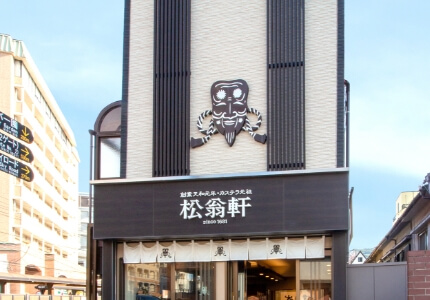

✅ Recommended Points
- Shooken is a long-established Japanese confectionery that has been in business for over 300 years since the mid-Edo period. Confectioners from Portugal, the home of Castella, once visited Shooken to learn how to make Castella.
- Founded in 1681, Shououken bakes each Castella piece by piece.
- Shooken has only stores in Nagasaki and Fukuoka, and its Castella name is the rarest and most valuable of the three Castella families.
- Shooken’s Castella are baked by hand, with artisans carefully baking them in their own kilns.
- The craftsmanship of changing the process slightly depending on the weather and temperature shines through, and the simple yet profound flavor can be enjoyed.
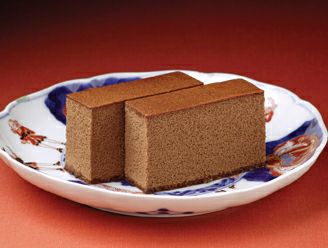

✅ Recommended products
- Chocolatte
- Chocolatte, the original chocolate-flavored Castella, is a popular product with a refreshing flavor that goes well with Japanese tea without being too chocolatey.
- Chocolatte” was created in the Meiji era (1868-1912) and was a rare chocolate Castella at that time. Its mild, aromatic and rich taste is still loved by many Nagasaki people.
- In addition to the familiar plain type, Shooken also sells Castella with different flavors such as matcha green tea flavor, chocolate flavor “Chocolatte”, and Gosan-yaki Castella.
- Visitors can enjoy a variety of Castella.
Each is a long-established shop with first-class products, so I guess I should treat myself. All the Castella look so delicious, I can’t decide which one to try…
Column: What is the Pomelo Lime on the Bottom of Castella for?
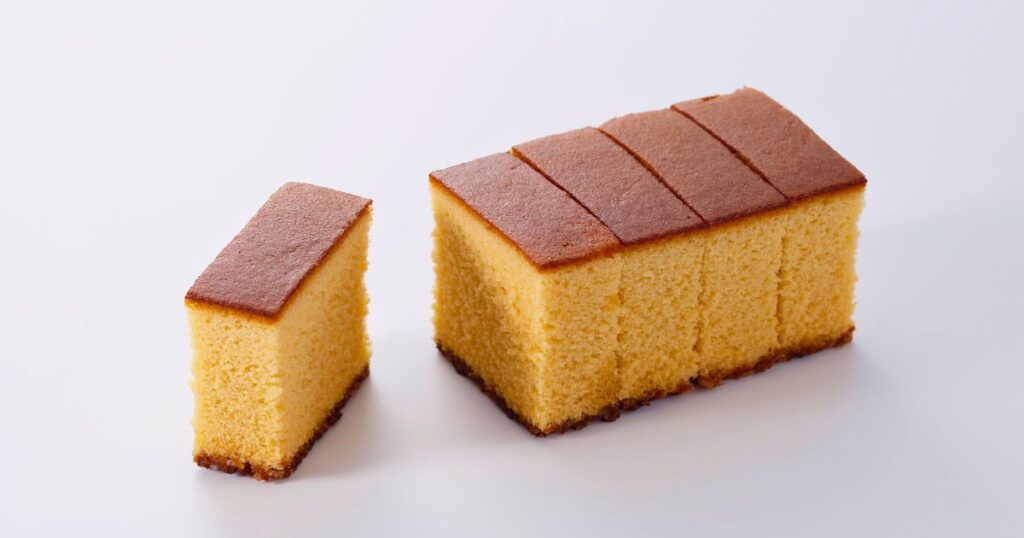

The sole on the bottom of Nagasaki Castella is not just for taste, but actually serves as a “preservative”.
In the Edo period (1603-1867), when Castella was presented to Kyoto and Edo (present-day Tokyo) from Nagasaki, it was transported by ship, which took a long time, so it was necessary to devise a way to make it last longer.
At the time, Nagasaki had plenty of sugar imported from China, so the Castella were covered with sugar as a preservative.
Sugar was used to prevent the growth of bacteria, and this was wisdom to make the Castella last longer.
Furthermore, the original coarse sugar was left on the bottom of the dough after it had been mixed into the batter and left unmelted during the baking process.
The technique of grinding down the corners of the pomegranate sugar while stirring, blending it into the dough, and leaving some of it to settle is a traditional technique that can only be performed by skilled artisans.
The granulated sugar gradually dissolves over time, and this has the effect of making the Castella even more moist.
Today, it plays an important role in accentuating the texture and has become a characteristic of Nagasaki Castella.
Oh, really? I didn’t know that the rough texture on the bottom of the Castella served as a preservative.
Three ways to enjoy Japanese Castella


To enjoy Japanese Castella to its fullest, try these tips:
✅ Enjoy it with beverages
There are various drinks that go well with Castella. The bitterness of coffee and the sweetness of Castella create a perfect balance, and the refreshing aroma of black tea enhances the sweetness of Castella. The refreshing aroma of black tea enhances the sweetness of the Castella.
Japanese teas (sencha, hojicha, matcha, etc.) also bring out the sweetness of the Castella and give it a refreshing aftertaste.
Some people say, “I enjoy it with a drink at lunchtime, when I am hungry, or as a small snack.
The good thing about Castella is that it is not as sweet as cake and can be eaten without hesitation when entertaining as a tea cakes.
Especially for foreign visitors to Japan, you can enjoy it with Japanese tea to experience its charm as a Japanese confectionery.
✅ Enjoying arrangements
Castella can not only be eaten as is, but can also be baked in butter to give it a charred look, topped with ice cream or red bean paste, and many other ways to enjoy it.
Baking and eating with ice cream are two of the most delicious ways to enjoy Fukusunaya Castella.
When baked, it becomes crispy on the outside and fluffy on the inside, giving the illusion that you are eating a different snack.
Taiwanese Castella is also claimed to be “delicious both freshly baked and cold,” and you can enjoy this new way of eating derived from the traditional Japanese Castella.
Other popular ways of eating Castella include pairing it with yogurt, honey, or jam, and you will discover a new way to enjoy the taste of Castella.
✅ Comparing Various Types of Castella
There are many different types of Castella. Gosan Castella, which contains more egg yolk than regular Castella and has a 5:3 egg yolk to egg white weight ratio, is a high-end product that requires a high level of skill, with flour reduced to the utmost limit.
The Japanese flavors such as green tea, red bean paste, yuzu and hojicha go well with Japanese tea, while the Western flavors such as chocolate, cheese and coffee can be enjoyed with tea or coffee, or with fresh cream.
There are also luxurious ones with gold leaf on the surface of the Castella, making them ideal as gifts for special celebrations.
For foreign visitors to Japan, comparing Castella from different long-established stores in Nagasaki will be a memorable part of a trip to learn more about Japanese food culture.
Indeed. It’s not as sweet as cake, so you can eat it quickly. So… be careful not to eat too much!
You can taste the delicious famous Castella at home!
Castella from famous stores are unbelievably delicious, and with Amazon, you can purchase items from the comfort of your own home.
In this article, I would like to introduce you to some of the Castella I recommend that you can purchase on Amazon.
Find the Castella of your choice and enjoy an elegant snack time from the comfort of your own home.
Please use this as a reference to find your favorite Castella.
I have selected items that are pleasantly affordable, so please use them as a reference in selecting a Castella.
If you are interested, check out the following products on Amazon!
Castella Honke Fukusaya Cube, Gift Set, Set of 10, Includes a Bag








Gosan-yaki Castella Half Roll, 1 Piece, Nagasaki Castella, Shooeken, Includes Carrying Bag




I have selected items that are pleasantly affordable, so please use them as a reference in selecting a Castella.


